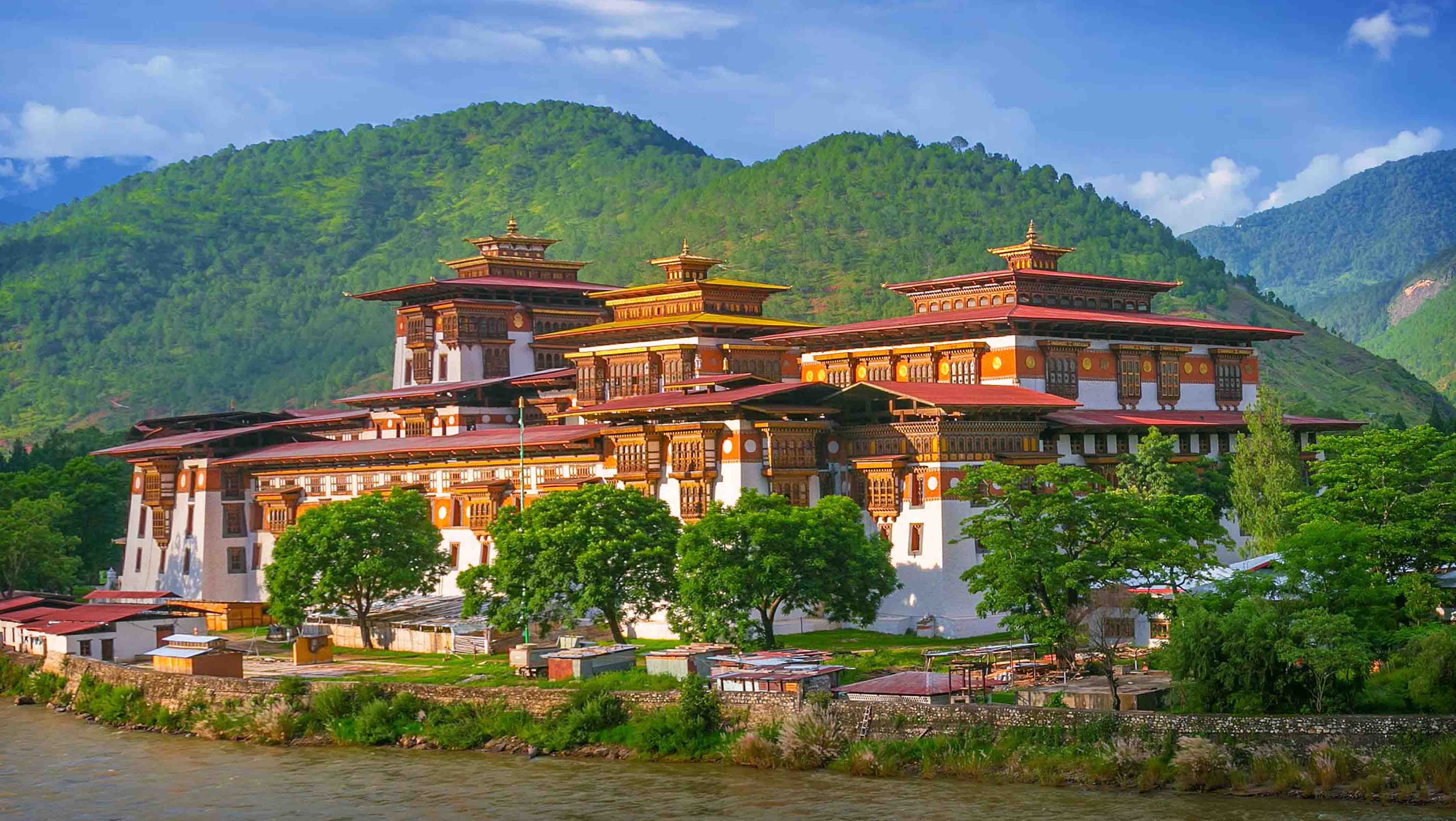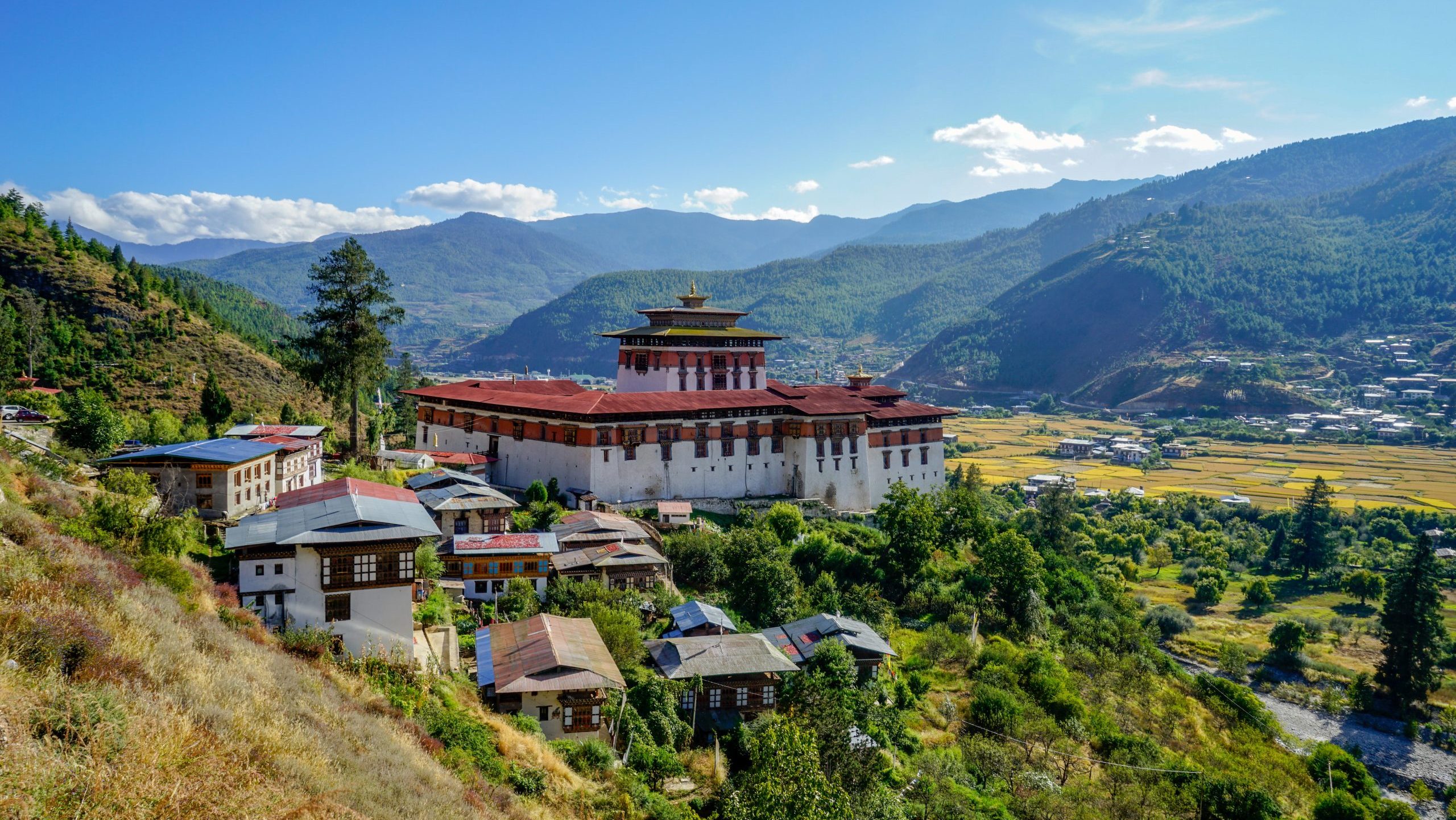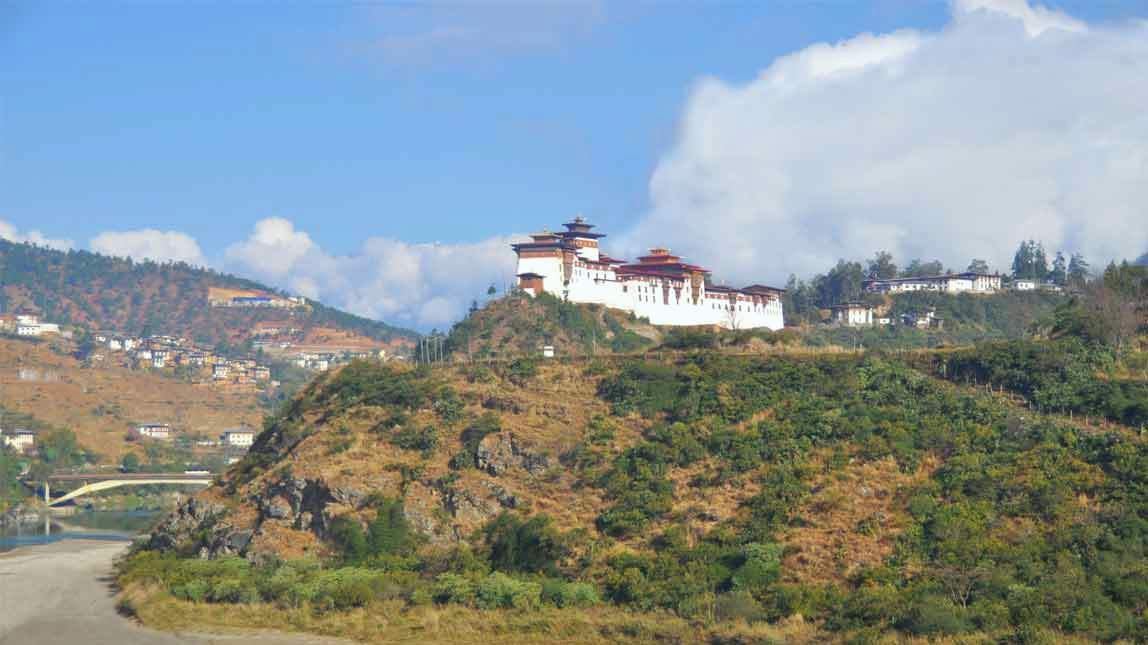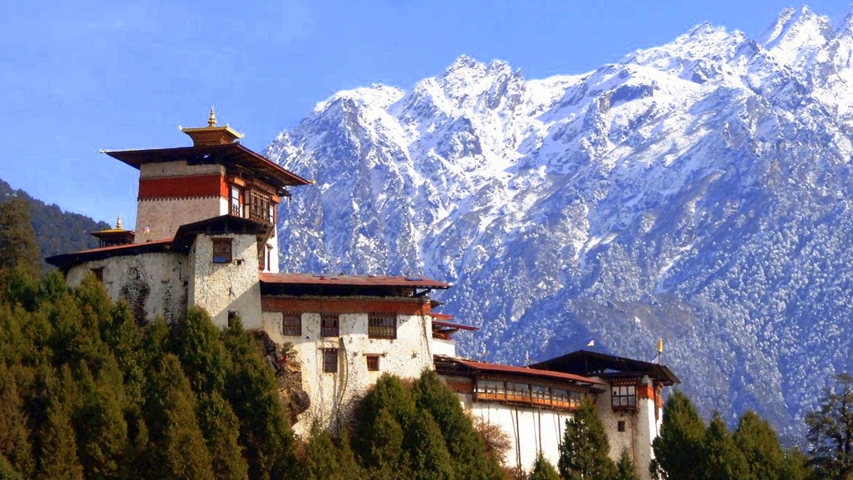Dzongs in Bhutan are grand fortress-monasteries that serve as administrative, military, and religious centers across the country. These iconic structures, rich in history and cultural significance, are a testament to Bhutan's unique blend of governance and spirituality. From the famous Punakha Dzong to the majestic Tashichho Dzong Thimphu, each dzong showcases Bhutanese architectural brilliance, featuring massive stone walls, intricate woodwork, and sacred temples. A visit to Bhutan is incomplete without exploring its famous dzongs, which not only offer a glimpse into the past but also play a vital role in the country's vibrant festivals and religious life.
At Amen Bhutan Tours and Treks, we pride ourselves on being the best company for exploring Dzongs in Bhutan. With our extensive knowledge of the country's rich history and cultural heritage, we offer expertly guided tours to the most famous dzongs of Bhutan, such as Punakha Dzong, Tashichho Dzong Thimphu, and Paro Rinpung Dzong. Our personalized itineraries ensure that you experience the architectural beauty, religious significance, and historical importance of these iconic fortress-monasteries. Whether you're interested in Bhutan's dzong festivals or its deep-rooted spiritual traditions, Amen Bhutan Tours and Treks guarantees an unforgettable journey through Bhutan's most revered dzong heritage sites.
Punakha Dzong
Punakha Dzong, also known as the "Palace of Great Happiness," is one of the most important and stunning fortresses in Bhutan. Located at the confluence of the Pho Chhu (male) and Mo Chhu (female) rivers, this dzong is renowned for its breathtaking beauty and historical significance. It served as the capital of Bhutan until 1955 and remains the winter residence of the monastic body.

Highlights of Punakha Dzong:
- Architectural Splendor: The dzong features intricate woodwork, towering white walls, and beautiful courtyards, making it one of the most picturesque fortresses in the country.
- Religious Significance: Punakha Dzong is home to sacred relics of the Drukpa lineage and is the site of the annual Punakha Dromche festival, celebrated with colorful mask dances and religious rituals.
- Historic Role: The dzong holds great importance in Bhutanese history, as it was the site of the first national assembly and the coronation of the first king of Bhutan in 1907.
- Scenic Location: Its location between two rivers adds to the natural beauty of the structure, making it a popular site for photographers and travelers alike.
Punakha Dzong stands as a symbol of Bhutan's rich heritage, combining religious importance, historical milestones, and architectural brilliance. Its serene location and deep cultural roots make it a must-visit destination for anyone exploring the dzongs in Bhutan.
Tashichho Dzong (Thimphu)
Tashichho Dzong, located in Bhutan's capital city of Thimphu, is a grand fortress that serves as both a religious and administrative center. Known as the "Fortress of the Glorious Religion," it is one of the most significant structures in Bhutan, symbolizing the blend of governance and spirituality that defines the nation.

Highlights of Tashichho Dzong:
- Architectural Beauty: The dzong's whitewashed walls, golden spires, and red and gold roofs exemplify the best of Bhutanese architecture. Its extensive courtyards and intricately designed prayer halls make it a striking landmark.
- Administrative Center: Tashichho Dzong houses the throne room and offices of the King of Bhutan, as well as the central government. It is also the summer residence of the monastic body, further emphasizing its dual role in the country's governance and spiritual life.
- Religious Significance: The dzong is home to the Je Khenpo (chief abbot) and monks during the summer months. It is also the site of the annual Thimphu Tsechu, a religious festival marked by traditional dances and cultural performances.
- Historic Role: The current structure was rebuilt in 1962 to complement the modernization of Thimphu as Bhutan's capital. Despite being renovated, the dzong has retained its traditional Bhutanese design.
Tashichho Dzong in Thimphu stands as a testament to Bhutan’s architectural elegance and its seamless fusion of religion and administration. As both a political hub and spiritual sanctuary, it remains one of the most important and frequently visited dzongs in Bhutan, reflecting the country’s deep-rooted cultural values.
Paro Rinpung Dzong
Paro Rinpung Dzong, meaning "Fortress on a Heap of Jewels," is one of the most prominent and visually stunning dzongs in Bhutan. Perched above the Paro Valley, this dzong is a key religious, administrative, and cultural center, offering visitors a glimpse into Bhutan's historical and spiritual heritage.

Highlights of Paro Rinpung Dzong:
- Architectural Marvel: The dzong’s massive walls, classic Bhutanese architecture, and commanding position overlooking the Paro Valley make it a striking landmark. The fortress is connected to the valley below by a traditional wooden bridge, adding to its charm.
- Religious Importance: Paro Rinpung Dzong houses the monastic body of Paro and is an important site for religious ceremonies. It also hosts the annual Paro Tsechu, a festival featuring vibrant dances and rituals that attract both locals and tourists.
- Cultural Significance: The dzong is home to several sacred temples and religious artifacts, making it an essential part of Bhutan’s cultural fabric. The dzong has also been recognized as a UNESCO tentative site for its architectural and historical value.
- Historical Role: Built in the 17th century, Paro Rinpung Dzong played a key role in defending the Paro Valley from invasions. It remains a central administrative center for the region and a symbol of Bhutan’s rich history.
Paro Rinpung Dzong stands as a beacon of Bhutanese tradition and history. Its breathtaking architecture, religious significance, and role in Bhutan’s defense make it one of the most essential and beautiful dzongs in Bhutan to explore. Visitors to Bhutan cannot miss the opportunity to experience the grandeur of this ancient fortress in the heart of the Paro Valley.
Trongsa Dzong
Trongsa Dzong, towering majestically over the Mangde River in central Bhutan, is one of the most important and largest fortresses in the country. Known as the "Fortress of the Vanguard of Warriors," it holds a vital place in Bhutan's history and continues to serve as both a religious and administrative hub.

Highlights of Trongsa Dzong:
- Strategic Location: Perched on a high ridge, Trongsa Dzong offers stunning views of the surrounding valleys and mountains. Its position allowed it to control the east-west trade route and provided a strategic military advantage during times of conflict.
- Royal Heritage: This dzong has a special connection with Bhutan’s royal family. Both the first and second kings of Bhutan ruled from Trongsa, and the current king continues the tradition of being appointed as the Trongsa Penlop (Governor) before ascending the throne.
- Architectural Grandeur: The dzong is a sprawling complex with multiple courtyards, temples, and administrative offices. Its maze-like corridors, massive walls, and striking design make it an architectural masterpiece that reflects the grandeur of Bhutanese craftsmanship.
- Religious Importance: Trongsa Dzong is not only an administrative center but also a significant religious site, housing over 200 monks. It is the venue for the annual Trongsa Tsechu, where traditional mask dances and rituals are performed.
- Historic Significance: Built in 1648, Trongsa Dzong played a crucial role in unifying Bhutan and controlling the central region. Its imposing structure symbolizes the strength and unity of the Bhutanese kingdom.
Trongsa Dzong is a must-visit for those interested in Bhutan’s royal and military history. Its impressive architecture, historical significance, and panoramic views of central Bhutan make it one of the most captivating dzongs in Bhutan. A visit to this fortress offers not only a glimpse into Bhutan’s past but also an appreciation of its cultural and religious depth.
Wangdue Phodrang Dzong
Wangdue Phodrang Dzong, strategically perched on a hilltop overlooking the Punakha Chhu and Tang Chhu rivers, is one of Bhutan's most significant dzongs. Known for its unique location and rich history, it plays a vital role in Bhutan's cultural and religious life. Although it was devastated by a fire in 2012, the dzong is undergoing careful reconstruction to restore its former grandeur.

Highlights of Wangdue Phodrang Dzong:
- Strategic Location: The dzong's elevated position offers breathtaking panoramic views of the surrounding valleys, rivers, and distant mountains. Its location was chosen for its defensive advantages, controlling the routes to central and southern Bhutan.
- Historic Significance: Built in 1638 by Zhabdrung Ngawang Namgyal, the founder of Bhutan, the dzong played a crucial role in protecting the region and controlling the trade routes. It was one of the largest and most important historic dzongs of Bhutan.
- Cultural and Religious Role: The dzong has always been a center for both administration and religion, housing the regional monk body during the winter months. It is also a key site for local festivals and religious ceremonies.
- Reconstruction Efforts: After the devastating fire in 2012, efforts have been made to restore Wangdue Phodrang Dzong to its former glory. The reconstruction respects traditional Bhutanese architectural methods, using natural materials and intricate woodwork to bring the dzong back to life.
- Architectural Significance: The dzong's design, characterized by its elongated structure and intricate wood carvings, reflects the architecture of Bhutanese dzongs. Its grandeur and scale make it one of the most impressive dzongs in Bhutan.
Wangdue Phodrang Dzong stands as a symbol of Bhutan's resilience and cultural pride. Though damaged by fire, the ongoing restoration efforts aim to preserve its historical and architectural significance. As one of the most strategically important and famous dzongs of Bhutan, it continues to be a key destination for those exploring the country's rich heritage.
Gasa Dzong
Gasa Dzong, also known as Tashi Thongmon Dzong, is a remote fortress located in the northern region of Bhutan, near the high-altitude peaks of the Himalayas. Perched at an elevation of 2,850 meters, this dzong is not only a significant historical and administrative center but also serves as a gateway to the famous Laya Gasa Trek. Its strategic location and rich history make it an essential stop for those exploring the region.

Highlights of Gasa Dzong:
- Scenic Location: Gasa Dzong is surrounded by the pristine wilderness of the Bhutanese Himalayas, offering stunning views of snow-capped mountains and lush forests. Its isolated setting makes it a unique dzong to visit, especially for nature lovers and trekkers.
- Historical Importance: Built in the 17th century by Zhabdrung Ngawang Namgyal to defend against Tibetan invasions, Gasa Dzong has played a crucial role in protecting the northern borders of Bhutan. Its defensive position atop a hill reflects its strategic military importance.
- Cultural Significance: The dzong is not only an administrative hub but also a religious site, housing a monastic body and serving as a venue for important local festivals, such as the Gasa Tsechu. These festivals highlight the cultural and spiritual life of the people in the region.
- Gateway to Treks: Gasa Dzong is a popular starting or ending point for treks, including the Laya Gasa Trek, one of the most challenging and scenic treks in Bhutan. The dzong's location makes it an essential stop for trekkers who seek both adventure and cultural experiences.
- Architecture: Like other dzongs in Bhutan, Gasa Dzong is built in the traditional Bhutanese architectural style, with towering whitewashed walls, intricate woodwork, and fortified structures that blend seamlessly with the natural landscape.
Gasa Dzong stands as a symbol of Bhutan’s defense and resilience, guarding the northern frontier while offering visitors a unique blend of history, culture, and nature. Its remote location and connection to trekking routes make it a must-visit for those looking to explore the dzongs in Bhutan off the beaten path. The serene beauty and rich heritage of Gasa Dzong create an unforgettable experience for travelers seeking both adventure and spiritual insight.
Simtokha Dzong
Simtokha Dzong, also known as Sangak Zabdhon Phodrang (Palace of Profound Meaning of Secret Mantras), is the oldest dzong in Bhutan, built in 1629 by Zhabdrung Ngawang Namgyal. Located just a few kilometers south of the capital, Thimphu, this dzong holds immense historical and religious significance as the foundation of Bhutan’s dzong system.

Highlights of Simtokha Dzong:
- Historical Importance: As the first dzong built by Zhabdrung Ngawang Namgyal, Simtokha Dzong marks the beginning of Bhutan's unified defense and administrative system. Its construction played a pivotal role in establishing control over western Bhutan.
- Religious and Educational Center: Unlike many other dzongs, Simtokha Dzong primarily serves as a center for religious learning. It houses one of the most prestigious Buddhist schools in the country, where monks study the teachings of the Buddha and Tibetan Buddhism.
- Architectural Heritage: Despite its relatively small size compared to other dzongs, Simtokha Dzong showcases classic Bhutanese architectural styles with massive stone walls, elegant wood carvings, and a central courtyard. Its simplicity reflects the early design of Bhutanese fortresses.
- Spiritual Significance: The dzong is home to numerous ancient Buddhist murals and statues, making it a spiritual treasure trove. Visitors can explore the prayer halls and shrines, which contain important religious artifacts.
- Cultural Significance: Simtokha Dzong has served various purposes over the centuries, from being a military fortification to an administrative center and religious institution. It has survived numerous historical events, preserving its status as a symbol of Bhutan’s heritage.
Simtokha Dzong stands as a testament to Bhutan’s early history and the foundation of its unique dzong system. Its role as both a spiritual and educational center, combined with its rich history, makes it an essential destination for those interested in the dzongs in Bhutan. Despite its smaller size, Simtokha Dzong’s significance in Bhutan’s cultural and religious fabric cannot be overstated.
Dzongs in Bhutan are not just architectural marvels but also the heart of the nation's cultural, religious, and administrative life. These fortress-monasteries, with their rich history and stunning craftsmanship, offer visitors a unique glimpse into Bhutan's deep-rooted traditions and spiritual heritage. Whether exploring the grandeur of Punakha Dzong, the strategic importance of Trongsa Dzong, or the serene beauty of Gasa Dzong, each dzong tells a story of Bhutan’s past and present. A visit to these iconic structures is an essential part of understanding and appreciating the true essence of Bhutan.
FAQs of the Dzongs in Bhutan
Q: What is a dzong in Bhutan?
A: A dzong is a fortress-monastery in Bhutan, serving both as an administrative center and a religious institution. These structures are integral to Bhutan’s governance and spiritual life, with stunning architecture that reflects the country’s cultural heritage.
Q: What is the significance of dzongs in Bhutan?
A: Dzongs hold dual importance in Bhutan. They serve as government offices and religious sites for monks. They are also the venue for important cultural festivals, such as Tsechus, and symbolize Bhutan’s unique blend of governance and spirituality.
Q: Which are the most famous dzongs to visit in Bhutan?
A: Some of the most famous dzongs in Bhutan include Punakha Dzong, Tashichho Dzong (Thimphu), Paro Rinpung Dzong, Trongsa Dzong, and Wangdue Phodrang Dzong. Each of these dzongs has its unique historical and cultural significance.
Q: Can visitors enter the dzongs in Bhutan?
A: Yes, most dzongs in Bhutan are open to visitors, although certain sections may be restricted to monks and government officials. It's important to dress modestly and respectfully when visiting these religious sites.
Q: What is the best time to visit dzongs in Bhutan?
A: The best time to visit dzongs in Bhutan is during the annual Tsechu festivals, held in different dzongs throughout the year. These festivals showcase Bhutanese culture through dances, rituals, and religious ceremonies.
Q: What is the architectural style of dzongs in Bhutan?
A: Dzongs are built in a traditional Bhutanese architectural style, characterized by thick stone walls, massive wooden beams, and intricately carved windows and doors. The design reflects both functionality for defense and aesthetic beauty.
Q: What is the historical role of dzongs in Bhutan?
A: Historically, dzongs served as fortresses to protect regions from invasions, particularly from Tibet. Over time, they evolved into centers for both government administration and religious activities.
Q: Are dzongs still used for administrative purposes today?
A: Yes, many dzongs, such as Tashichho Dzong in Thimphu, continue to function as administrative centers for government offices while also housing monks and serving as religious sites.
Q: How long does it take to explore a dzong?
A: Depending on the size of the dzong and the areas open to visitors, it typically takes 1-2 hours to explore a dzong, including time to appreciate the architecture, visit temples, and learn about its history.
Q: Are there guided tours available for visiting dzongs in Bhutan?
A: Yes, many tour operators provide guided tours of dzongs, offering insights into their history, architecture, and cultural significance. A guided tour is recommended for a deeper understanding of these important landmarks.
If you are looking for tour packages in Bhutan please click here
If you need any further information, please contact us, Email: at [email protected] , Phone (Whatsapp or Viber) +975-1755-6636
